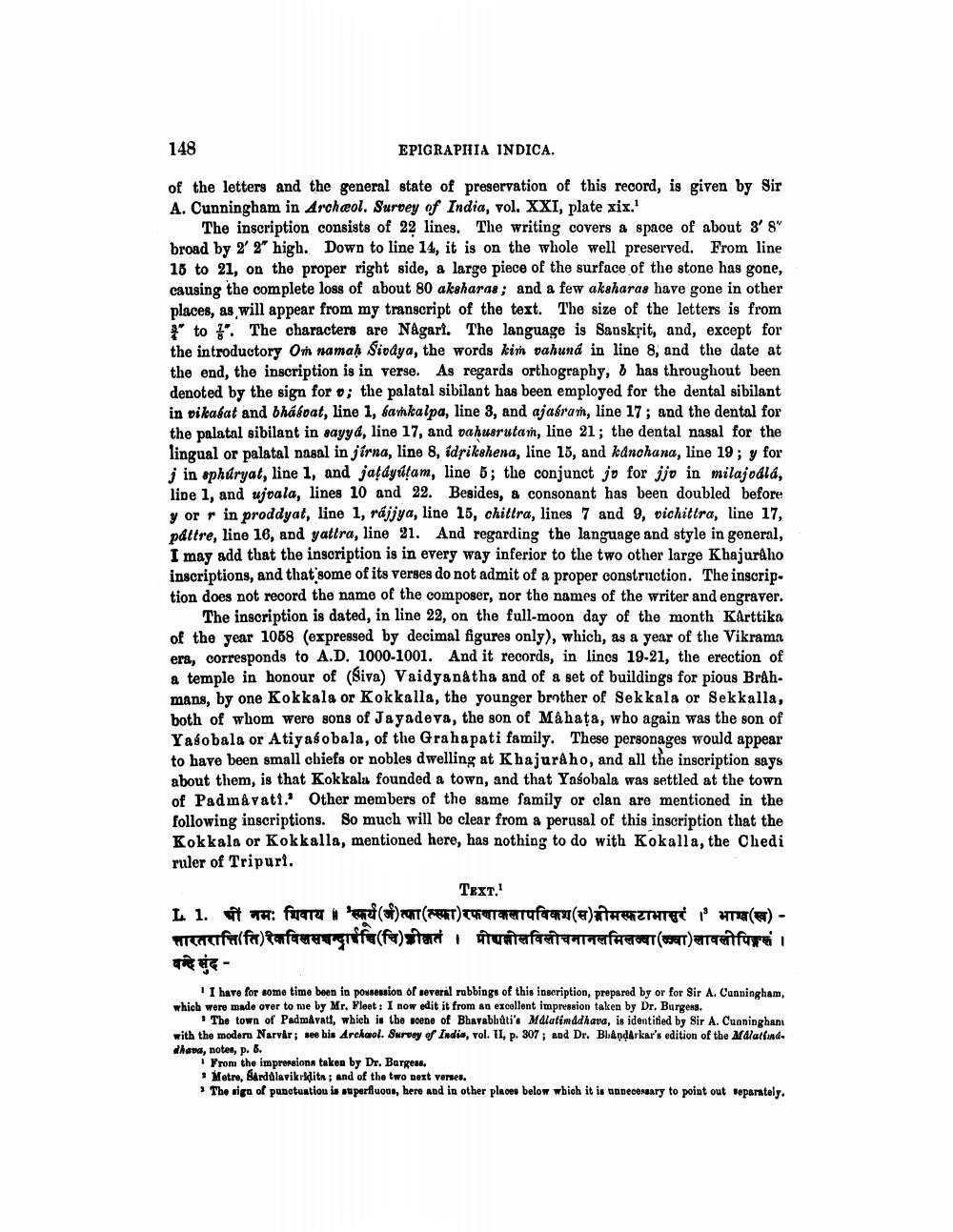________________
148
EPIGRAPHIA INDICA.
of the letters and the general state of preservation of this record, is given by Sir A. Cunningham in Archeol. Survey of India, vol. XXI, plate xix.
The inscription consists of 22 lines. The writing covers a space of about 3' 8" broad by 2' 2" high. Down to line 14, it is on the whole well preserved. From line 15 to 21, on the proper right side, a large piece of the surface of the stone has gone, causing the complete loss of about 80 aksharas ; and a few aksharas have gone in other places, as will appear from my transcript of the text. The size of the letters is from t" to ". The characters are Nagart. The language is Sanskřit, and, except for the introductory Om namah Sivdya, the words kim vahund in line 8, and the date at the end, the inscription is in verse. As regards orthography, 6 has throughout been denoted by the sign for o; the palatal sibilant has been employed for the dental sibilant in vika at and bháboat, line 1, bankalpa, line 3, and ajasrar, line 17: and the dental for the palatal sibilant in sayya, line 17, and vahusrutan, line 21; the dental nasal for the lingual or palatal nasal in jírna, line 8, idrikshena, line 15, and kanchana, line 19; y for j in spharyat, line 1, and jafdyútam, line 5; the conjunct jo for jjo in milajodlá, lipe 1, and ujsala, lines 10 and 22. Besides, & consonant has been doubled before y or r in proddyat, line 1, rájiya, line 15, chitlra, lines 7 and 9, vichittra, line 17, pattre, line 16, and yattra, line 21. And regarding the language and style in general, I may add that the inscription is in every way inferior to the two other large Khajuraho inscriptions, and that some of its verses do not admit of a proper construction. The inscription does not record the name of the composer, nor the names of the writer and engraver.
The inscription is dated, in line 22, on the full-moon day of the month Karttika of the year 1058 (expressed by decimal figures only), which, as a year of the Vikrama era, corresponds to A.D. 1000-1001. And it records, in lincs 19-21, the erection of a temple in honour of (Siva) Vaidyanatha and of a set of buildings for pious Brahmans, by one Kokkala or Kokkalla, the younger brother of Sekkala or Sekkalla, both of whom were song of Jayadeva, the son of Mahata, who again was the son of Yasobala or Atiyasobala, of the Grahapati family. These personages would appear to have been small chiefs or nobles dwelling at Khajuraho, and all the inscription says about them, is that Kokkalu founded a town, and that Yasobala was settled at the town of Padmavati. Other members of the same family or clan are mentioned in the following inscriptions. So much will be clear from a perusal of this inscription that the Kokkala or Kokkalla, mentioned here, has nothing to do with Kokalla, the Chedi ruler of Tripuri.
Text. L 1. î TH: fwr i'et (of) RAT (PAT)
T aryfant(e) HEATHTEE HTT(AT) - Tarcfalfat) afowanife(fa) staat uiterfaitairefarout(at)arentfura TRE
I have for some time been in possession of several rubbings of this inscription, prepared by or for Sir A. Cunningham, which were made over to me by Mr. Fleet: I now edit it from an excellent impression taken by Dr. Burgens.
The town of Padmavati, which is the scene of Bhavabbâti's Malatimddhava, is identified by Sir A. Cunningham with the modern Narvár: see his Archaol. Survey of India, vol. II, p. 307; and Dr. BlandArkar's edition of the Malatlind. dhana, notes, p. 6.
From the impresiona taken by Dr. Bargese. • Metro, Sardilavikridita; and of the two next verses. * The sign of punctuation is superfluous, here and in other places below which it is unnecessary to point out separately.




